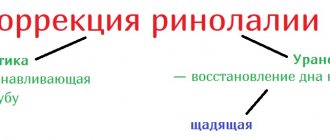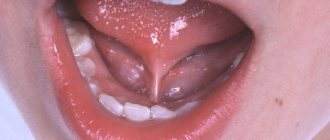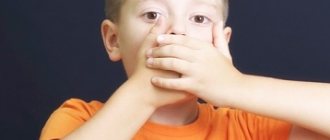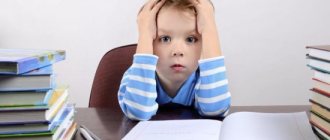Sensorimotor alalia in children is a severe disorder in which oral speech is significantly difficult or absent. The cause of the defect is damage to the speech centers of the brain, which are responsible for the perception and reproduction of speech. In this article we will look at the causes, treatment and prognosis of sensory-motor alalia, and will tell you how to behave as parents of a child with such a pathology.
Causes of the disease
Sensorimotor alalia develops due to damage to areas of the brain that are responsible for understanding and reproducing speech.
A damaging factor can affect different periods of a child’s development:
- In the prenatal period, infectious diseases in a woman, the threat of miscarriage, polyhydramnios or oligohydramnios, premature rupture of water, entanglement in the umbilical cord, bad habits, taking medications, concomitant diseases, vitamin deficiencies have a negative impact;
- During childbirth, there is an increased risk of birth injuries and hypoxia, in which the brain experiences oxygen deficiency or is damaged. The use of forceps and rapid labor are dangerous;
- After childbirth and the first years of the baby’s life, brain damage can occur as a result of injuries, encephalitis and meningitis, and severe concomitant diseases.
Relationships with parents play an important role in the development of sensorimotor alalia. It has been proven that children whose parents are distant towards their baby ignore his needs for love, communication, care, and lag behind their peers in development. This also applies to speech development.
Symptoms of sensorimotor alalia in children
The clinical picture is characterized by severe speech disorder. If with motor alalia pronunciation suffers, sensory alalia affects the understanding of speech and its analysis, then with sensorimotor alalia both components are affected. The disorder may also affect the association center, the area of the brain that controls the construction of phrases and sentences.
Let's look at these violations in more detail:
- Expressive language disorder is the inability to produce sounds. At the same time, there are no hearing impairments, and there is also no pathology of the articulation organs. The child pronounces the first word only at the age of 3–4 years. In conversation he uses onomatopoeia, gestures, and babble. Replaces sounds or skips them, repeats words uncontrollably, but cannot repeat words when asked, purposefully. Uses mostly nouns;
- Impressive speech disorder is characterized by a lack of understanding of speech addressed to him. Although the child hears sounds and words perfectly, he cannot analyze them and respond adequately. In some cases, there is no reaction even to one’s own name. At the same time, he unconsciously repeats words and syllables, but at the request of an adult he cannot do this. Logorrhea is characteristic - verbosity, but speech is inarticulate, consisting of individual interjections and babbling words.
In an unfamiliar environment, sensorimotor alalia becomes more pronounced. For example, if at home a child reacts to his mother’s words, answers them correctly or reacts accordingly, then elsewhere he understands absolutely nothing and does not react.
Vocabulary is limited. The baby does not know how to inflect words and confuses cases, numbers, and genders. Grammar, writing, and reading suffer. Due to difficulties with speech perception, it is difficult for them to assimilate school material.
Such children are characterized by impulsiveness and an unstable emotional background. Because of this, they cannot communicate with other people, they have no friends. They usually stay apart from the team. This later leads to psychological problems.
With severe sensorimotor alalia, neurological disorders and symptoms are associated:
- Difficulties with coordination and fine motor skills;
- Clumsiness;
- Cognitive disorders - impaired memory, attention, concentration;
- Restlessness, fussiness, or vice versa, lethargy and slowness;
- Stuttering;
- Enuresis;
- Sleep and appetite disorders.
Severity
Depending on the depth of brain damage, signs of sensorimotor alalia in children can be of varying degrees of severity:
- a mild degree is characterized by minor violations - a change in the sequence of sounds in a word, the use of only simple phrases of 2 - 3 words. It is possible to understand what a child is talking about;
- with sensorimotor alalia of moderate severity, understanding the speech of the baby is difficult, there are problems with pronouncing sounds, constructing even simple phrases;
- a severe degree is accompanied by a lack of reaction to someone else’s speech and the absence or difficulty of one’s own speech.
Symptoms and signs of alalia.
Symptoms primarily depend on the type of alalia. Motor alalia has characteristic symptoms: poor development of hand movements; poor coordination; poor performance; speech can only appear by age 4; inability to express one's thoughts in words; replacing some words with others; incorrectly constructed sentences; reluctance to talk; touchiness, isolation, aggressiveness. Sensory alalia has characteristic symptoms: impaired speech perception; repeating words after someone; isolation; changing letters in words; merging several words into one; impulsiveness, increased activity, but at the same time the child may be withdrawn or depressed by something; lack of connection between an object and the word that denotes it.
FORMS OF ALALIA:
Pediatric neurologists and reflexotherapists distinguish 2 main forms of alalia: motor alalia, sensory alalia.
Diagnosis of sensorimotor alalia in children
The diagnosis of sensorimotor alalia is made on the basis of an examination with the participation of a neurologist, speech therapist, otolaryngologist, psychologist, and pediatrician. If necessary, consultations with other specialists are prescribed. The purpose of diagnosis is to identify the exact cause of the defect and exclude other health problems that may be accompanied by speech disorders: autism, hearing loss, mental disorders.
To clarify the diagnosis and identify signs of brain damage, exclude space-occupying formations, and vascular problems, a small patient is referred to electroencephalography, vascular Doppler, MRI or CT.
Treatment of sensory and motor alalia
Children suffering from alalia are often difficult to raise. Parents may treat such children unfairly because they do not understand the difficulties their children face. It is very important to realize that especially such children require a calm approach and understanding. If you notice symptoms of alalia in a child, you should immediately contact him or her to specialists: a speech therapist, a child neurologist, a child psychologist, a pediatric otolaryngologist to identify the causes of speech impairment.
For diagnosis, a comprehensive examination may be prescribed, including EEG, MRI of the brain, studies of auditory functions (audiometry), diagnostics of oral speech, auditory-verbal memory.
Treatment of alalia includes psychological, pedagogical, and, if necessary, medicinal aspects. Transcranial electrical stimulation and biofeedback techniques, aimed at restoring and forming cortical and subcortical connections in the brain, bring a significant effect in restoring speech functions. In the process of correcting alalia, the child should participate in developmental activities, such as
- gymnastics and rhythmics,
- artistic and technical classes,
- the science of reading, speaking, understanding, writing and counting.
- training of memory, attention and perception, which are designed to accelerate the development of mental functions, including the development and correction of speech. The form of the lesson and its features are selected individually for each child.
Information about the work of specialists in our Center and making an appointment can be made by calling 8 (812) 385-53-40
Treatment of sensorimotor alalia in children
Therapy for children diagnosed with sensorimotor alalia should be comprehensive, based on the individual characteristics of the disease in a particular child. It is also necessary to be systematic and attend classes regularly.
Treatment consists of medical, speech therapy, and psychological assistance.
The medical component of therapy consists of prescribing medications that stimulate brain metabolism and restore connections between neurons. Nootropics, multivitamins and other groups of drugs are used as needed. The course includes physiotherapeutic techniques (laser therapy, acupuncture, electrophonophoresis, electrical stimulation, magnetic therapy), massage.
Corrective classes for child speech development
The basis for correcting speech disorders with signs of sensorimotor alalia in children is working with a speech therapist or speech pathologist. Group classes are possible, but at the initial stage it is better to study individually.
The specialist helps step by step:
- at the first stage, teaches how to correctly perceive and reproduce sounds and words;
- The second stage of therapy is aimed at constructing words and short phrases and developing dialogue skills. At the same time, the set of words in the lexicon is enriched;
- The third stage of correctional work consists of developing monologue speech and consolidating grammar.
Classes are conducted in a playful way, using toys and pictures. Usually the baby undergoes therapy on an outpatient basis. But in more complex cases, hospitalization in specialized hospitals is indicated.
It is useful to develop fine motor skills. Drawing, classes with construction sets, mosaics, modeling, and appliques are suitable for these purposes. Alternative methods include hydrotherapy (hydromassage, swimming pool, therapeutic baths), and treatment with animals (dolphin therapy, hippotherapy).
A psychologist also works with the child. Under his control, the baby learns communication skills and control of the emotional and volitional sphere.
Correcting echolalia in a child at home
Many parents become frustrated by their child's lack of understanding of speech.
How can we help him in the initial stages of development? Always try to show your child what he says is meaningless. For example, he says out of place “Go to sleep!” It is important at this moment to take the child by the hand, approach the bed and, throwing back the blanket, lie down with him, saying “Go to sleep!”
Or the child suddenly says out of place, “Oh, I fell!” - you pick up any soft toy and throw it on the floor in front of the child’s face with the words “Oh, I fell!” It is advisable to demonstrate all this several times, throwing and picking up the toy and repeating this process over and over again exactly as the child said it a few seconds ago.
It is important that your demonstration of everything that the child will randomly pronounce is immediate. Yes, it’s quite exhausting, a hundred times a day, and the main thing is to demonstrate as quickly as possible, to show everything that the child says echolally.
But! It works! Sooner or later, the child will simply get tired of watching you do the same action several times a day, “forcing” him to look at it, and do all the actions that he senselessly lists, and the child will begin to “miss out”, starting his next echolalia phrase. That is, he will begin to stop his own meaningless utterance, which again and again involves him in doing the same action.
Children are very inquisitive and hate routine. And the concept that every phrase they speak has a visual solution will sooner or later force your child to speak only to the point .
Prognosis and prevention
The prognosis depends on the age at which sensorimotor alalia is diagnosed in children and the timing of initiation of therapy. If the diagnosis is made in preschool age, the child receives adequate treatment, regularly works with a speech therapist and psychologist, then it is possible to stop the progression of the disease and teach the patient communication skills. Articulation is normalized. Subsequently, he is socialized and can study in a regular school.
The participation of parents in the correction of sensorimotor alalia and their understanding of the complexity of the situation is very important. Unfortunately, such violations do not go away on their own. A good result requires patience, desire and effort on the part of both parents and baby. Try to motivate the baby, encourage, praise for success. Follow your speech therapist's recommendations.
If you trigger sensorimotor alalia, then stuttering, mental retardation, and nervous tics may occur. This will worsen the already difficult prognosis and negatively affect the future life of the child.
Prevention consists of clear pregnancy planning. The expectant mother should eat a balanced diet, get enough rest, and see a doctor regularly. During childbirth and the first years of the baby’s life, you should carefully monitor its development, prevent injuries and promptly treat infectious and other diseases.
If you find symptoms of sensorimotor alalia, contact a specialist so that they can examine you and identify the cause of this condition.
Symptoms of sensory alalia
The sensory alalik is not at all silent. Children have active—sometimes even overly—expressive speech. However, at the same time, they are absolutely not critical of their statements, not understanding themselves what exactly they are saying.
Characteristic features of sensory alalia:
- The mindless repetition of frequently heard phrases is echolalia. The child may persistently repeat advertising slogans, words of cartoon characters, etc. Sometimes speech may seem meaningful if the child repeats the last word he heard along with the answer. But if you change the phrase, there will be no result.
- Frequent confusion of words, syllables and phrases, the use of made-up words - the so-called logorrhea - is another characteristic symptom of sensory alalia.
- In most cases (about 70%), hearing remains intact. However, there is instability of auditory attention. In addition, many alaliks suffer from hyperacusis - increased sensitivity to certain sounds.
- Phonemic speech perception is impaired. That is, the chain through which auditory excitation is transmitted to brain structures associated with speech “does not work” in the child.
- There are also some memory impairments. In order to remember a word or phrase, alalik requires quite a lot of repetition.
So, speech with sensory alalia is absent not because the child has disorders of the auditory or speech or articulatory apparatus, but due to the inability to form a connection between the sound of a word and an object.





